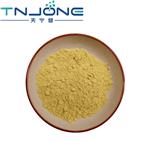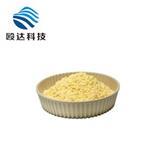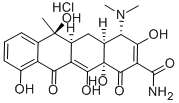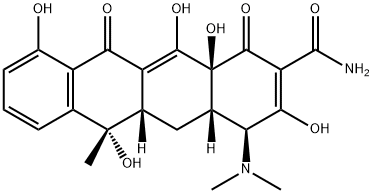Tetracycline hydrochloride
- CAS No.
- 64-75-5
- Chemical Name:
- Tetracycline hydrochloride
- Synonyms
- TETRACYCLINE HCL;sumycin;cyclopar;tetrachel;topicycline;cancycline-250;Tetracyclin HCl;amycin,hydrochloride;ACHROMYCIN HYDROCHLORIDE;alatet
- CBNumber:
- CB1704886
- Molecular Formula:
- C22H25ClN2O8
- Molecular Weight:
- 480.9
- MDL Number:
- MFCD00078142
- MOL File:
- 64-75-5.mol
| Melting point | 220-223 °C(lit.) |
|---|---|
| alpha | -252 º (c=0.5, H2O) |
| refractive index | -253 ° (C=0.5, 0.1mol/L HCl) |
| storage temp. | Keep in dark place,Inert atmosphere,Store in freezer, under -20°C |
| solubility | H2O: 10 mg/mL as a stock solution. Stock solutions should be filtered sterilized and stored at −20°C. Stable at 37°C for 4 days. |
| form | powder |
| color | faint yellow to yellow |
| PH | pH(10g/l, 25℃) : 1.8~3.0 |
| optical activity | [α]/D -255 to 240° (Specific rotation ) |
| Water Solubility | 50 g/L |
| Sensitive | Air & Light Sensitive |
| Merck | 14,9196 |
| BRN | 3844873 |
| Stability | Stable. Incompatible with strong oxidizing agents. |
| InChIKey | XMEVHPAGJVLHIG-FMZCEJRJSA-N |
| CAS DataBase Reference | 64-75-5(CAS DataBase Reference) |
| FDA UNII | P6R62377KV |
| Proposition 65 List | Tetracycline Hydrochloride (internal use) |
| NCI Drug Dictionary | tetracycline hydrochloride |
| EPA Substance Registry System | Tetracycline hydrochloride (64-75-5) |
SAFETY
Risk and Safety Statements
| Symbol(GHS) |    GHS07,GHS08,GHS09 |
|||||||||
|---|---|---|---|---|---|---|---|---|---|---|
| Signal word | Warning | |||||||||
| Hazard statements | H315-H319-H335-H361fd-H410 | |||||||||
| Precautionary statements | P202-P261-P273-P302+P352-P305+P351+P338-P308+P313 | |||||||||
| Hazard Codes | Xi,Xn | |||||||||
| Risk Statements | 36/37/38-20/21/22 | |||||||||
| Safety Statements | 26-36 | |||||||||
| RIDADR | UN 3077 9 / PGIII | |||||||||
| WGK Germany | 2 | |||||||||
| RTECS | QI9100000 | |||||||||
| F | 8-10-23 | |||||||||
| TSCA | Yes | |||||||||
| HazardClass | 3 | |||||||||
| HS Code | 29413000 | |||||||||
| Toxicity | LD50 orally in rats: 6443 mg/kg (Goldenthal) | |||||||||
| NFPA 704 |
|
Tetracycline hydrochloride price More Price(53)
| Manufacturer | Product number | Product description | CAS number | Packaging | Price | Updated | Buy |
|---|---|---|---|---|---|---|---|
| Sigma-Aldrich | 31741 | Tetracycline hydrochloride VETRANAL | 64-75-5 | 250mg | $60.7 | 2024-03-01 | Buy |
| Sigma-Aldrich | 1651009 | Tetracycline hydrochloride United States Pharmacopeia (USP) Reference Standard | 64-75-5 | 200mg | $436 | 2024-03-01 | Buy |
| Sigma-Aldrich | T0600000 | Tetracycline hydrochloride European Pharmacopoeia (EP) Reference Standard | 64-75-5 | T0600000 | $212 | 2023-06-20 | Buy |
| Sigma-Aldrich | 58346-M | Tetracycline, Hydrochloride - CAS 64-75-5 - Calbiochem | 64-75-5 | 10g | $54.5 | 2023-01-07 | Buy |
| Sigma-Aldrich | 58346-M | Tetracycline, Hydrochloride - CAS 64-75-5 - Calbiochem | 64-75-5 | 25g | $63.8 | 2022-05-15 | Buy |
Tetracycline hydrochloride Chemical Properties,Uses,Production
Chemistry
Tetracyclines and analogues with biological effects on bacteria and mammalian targets show a basic chemical structure consisting of a tetracyclic naphthacene carboxamide ring system (Fig 1). Tetracyclines with antibiotic activity have a dimethylamine group at carbon 4 (C4) in ring A. Removal of the dimethylamino group from C4 reduces its antibiotic properties, but enhances non-antibiotic actions[3]. Utilization of this strategy was the basis for the development of several chemically modified tetracyclines[2]. The ring structure of tetracyclines is surrounded by upper and lower peripheral zones. These contain various chemical functional groups and substituents[12]. Synthetic modification of the lower peripheral region reduces both antibiotic and non-antibiotic properties. On the other hand, biological targets may be enhanced by modifying the upper peripheral zone, particularly in positions C7 through C9 of the D ring. This has been accomplished with tetracycline semisynthetic compounds such as minocycline and doxycycline[3].
Indication
Tetracyline hydrochloride is used for the treatment of bacterial infections such as Rocky Mountain spotted fever, typhus fever, tick fevers, Q fever, rickettsia pox and Brill-Zinsser disease. May be used to treat infections caused by Chlamydiae spp., B. burgdorferi (Lyme disease), and upper respiratory infections caused by typical (S. pneumoniae, H. influenzae, and M. catarrhalis) and atypical organisms (C. pneumoniae, M. pneumoniae, L. pneumophila). May also be used to treat acne. Tetracycline may be an alternative drug for people who are allergic to penicillin.
Mode of action
The tetracyclines inhibit bacterial growth primarily by inhibiting protein synthesis at the level of the ribosome[13-16]. Inhibition of protein synthesis results from disruption of codon-anticodon interactions between tRNA and mRNA so that binding of aminoacyl-tRNA to the ribosomal acceptor (A) site is prevented[14, 15]. The precise mechanism by which tetracyclines prevent attachment of aminoacyl-tRNA to the A site is not understood. However, inhibition is likely to result from interaction of these antibiotics with the 30S ribosomal subunit since many of the tetracyclines are known to bind strongly to a single site on the 30S subunit[15]. Nevertheless, interaction of these tetracyclines with the 30S ribosomal subunit is reversible since these agents are bacteriostatic.
Pharmacodynamic
Absorption is variable ranging from 0% to almost 90%; however, for most agents it is in the range 25–60%[17]. Serum concentrations rise slowly after oral administration with absorption occurring in the stomach, duodenum and small intestine. Cmax (mg/L) depends on dose, but is generally in the range 1–5 mg/L. Tmax is in the range 2–4 h. All these tetracyclines form insoluble complexes with calcium, magnesium, iron and aluminium, which markedly reduce absorption[18]. the effect of disease on the absorption of these drugs is unknown. Protein, fat and carbohydrate meals reduce the absorption of tetracycline by about 50%[16]. The volume of distribution (V) for these agents is in the order of 1.3–1.7 L/kg or a total volume of distribution of 100–130 L. These data imply some concentration in tissues; however, most data on tissue penetration are of poor quality, making firm conclusions about their relative distribution difficult. Protein binding is variable. None of these agents undergoes metabolism with the exception of tetracycline, 5% of which is excreted as the metabolite D-epitetracycline. Unchanged drugs are excreted by renal and bilary routes. Renal elimination (CLR) is related to glomerular filtration for most agents, the exception being chlortetracycline.[19, 20] The amount of drug excreted in the urine is <50%; rolitetracycline is said to have high renal elimination. Greater than 40% appears in the faeces after biliary elimination and most drugs have some enterohepatic circulation.[18, 22]
Resistance issue
Bacterial resistance to clinically useful tetracyciines is predominantly due to acquired resistance i.e. when resistant strains emerge from previously sensitive bacterial populations by acquisition of resistant genes. In essence, this results from the selective pressure exerted on bacteria during the administration of tetracyciines for chemotherapy in humans and animals. The genes determining resistance to tetracyciines usually reside in plasmids and/or transposons[11, 15]. It is now well recognized that acquisition of resistance determinants on plasmids and transposons is particularly important in the evolution of antibiotic resistant bacteria because it provides the recipient cell with pre-evolved genes refined to express high-level resistance[23].
Three distinct biochemical mechanisms of resistance to tetracyciines have been identified: (a) energy-dependent efflux of antibiotic mediated by resistance proteins that are inserted into the bacterial cytoplasmic membrane[15, 24, 25]; (b) ribosomal protection whereby tetracyciines no longer bind productively to the bacterial ribosome[25, 26], and (c) chemical alteration of the tetracycline molecule by a reaction that requires oxygen and which renders the drug inactive as an inhibitor of protein synthesis[25].
Side effects
The ability of tetracyclines to cause permanent discolouration of teeth is well-known and therefore these antibiotics are not administered to children less than eight years old. Tetracyclines are also contra-indicated in children because they can cause temporary inhibition of bone growth. Tetracyclines can produce Candida! Overgrowth or diarrhoea due to the relatively high proportion of antibiotic reaches the lower gastrointestinal tract. These antibiotics tend to accumulate in patients with renal insufficiency and may cause further impairment of renal function including nephrotoxicity and/or nephrogenic diabetes insipidus. Phototoxic reactions occasionally occur with tetracycline and minocycline, but are less common with doxycycline. Rarely, tetracyclines may cause benign intracranial hypertension, presenting as blurring of vision and headache often in young adults who are being treated for acne[27]. Minocycline can cause vestibular disturbance. Amongst the tetracyclines this effect is apparently unique to minocycline and probably relates to the high lipid solubility of the drug. The lipid-laden cells of the vestibular apparatus are believed to concentrate the drug resulting in vertigo and nausea. However, the effects are reversible upon discontinuation of therapy with the antibiotic.
Description
Tetracycline is a broad-
Chemical Properties
Yellow crystalline powder
Uses
Antibiotic substance produced by Streptomyces spp. Antiamebic; antibacterial; antirickettsial.
Uses
Tetracycline hydrochloride is used to induce apoptosis in osteoclasts. It is used to treat acne and other skin infections, respiratory tract infections like pneumonia, genital, urinary infections, leptospirosis, helicobacter pylori, taxoplasmosis, mycoplasma, psittacosis for dog and cats. It also works more effectively in animals that have tick-borne infections. It is also useful in cell culture applications.
Uses
Tetracycline hydrochloride is a salt prepared from tetracycline taking advantage of the basic dimethylamino group which protonates and readily forms the salt in hydrochloric acid solutions. The hydrochloride is the preferred formulation for pharmaceutical applications. Tetracycline hydrochloride has broad spectrum antibacterial and antiprotozoan activity and acts by binding to the 30S and 50S ribosomal sub-unit,s blocking protein synthesis.
General Description
Crystals or fine bright yellow powder. pH of 2% aqueous solution: 2.1 - 2.3.
Air & Water Reactions
Water soluble.
Reactivity Profile
Tetracycline hydrochloride is acidic. Reacts with strong oxidizing agents .
Fire Hazard
Flash point data concerning Tetracycline hydrochloride are not available, however, Tetracycline hydrochloride is probably combustible.
Biochem/physiol Actions
Primary Targetbinding of aminoacyl tRNA to the A-site of ribosomes
Safety Profile
Poison by intraperitoneal and intravenous routes. Moderately toxic by ingestion and subcutaneous routes. Human systemic effects: change in taste function. An experimental teratogen. Experimental reproductive effects. Mutation data reported. When heated to decomposition it emits very toxic fumes of HCl and NOx. See also TETRACYCLINE.
Veterinary Drugs and Treatments
While tetracycline still is used as an antimicrobial, most small animal clinicians prefer doxycycline and large animal clinicians prefer oxytetracycline when a tetracycline is indicated to treat susceptible infections. The most common use of tetracycline HCl today is in combination with niacinamide for the treatment of certain immune- mediated skin conditions in dogs, such as pemphigus.
Purification Methods
The hydrochloride is recrystallised from MeOH/n-BuOH or n-BuOH/HCl. It is insoluble in Et2O and pet ether. It has UV max at 270 and 366nm in MeOH. [Gottstein et al. J Am Chem Soc 81 1198 1959, Conover et al. J Am Chem Soc 84 3222 1962, Stephen et al. J Am Chem Soc 78 4155 1956, Beilstein 14 IV 2627.]
Tetracycline hydrochloride Preparation Products And Raw materials
Raw materials
1of2
Preparation Products
| Supplier | Tel | Country | ProdList | Advantage | |
|---|---|---|---|---|---|
| Wuhan Fortuna Chemical Co., Ltd | +86-27-59207850 +86-13986145403 | info@fortunachem.com | China | 5985 | 58 |
| Hebei Mojin Biotechnology Co., Ltd | +8613288715578 | sales@hbmojin.com | China | 12453 | 58 |
| Hebei Yanxi Chemical Co., Ltd. | +8617531190177 | peter@yan-xi.com | China | 5993 | 58 |
| Henan Bao Enluo International TradeCo.,LTD | +86-17331933971 +86-17331933971 | deasea125996@gmail.com | China | 2503 | 58 |
| Xiamen Wonderful Bio Technology Co., Ltd. | +8613043004613 | Sara@xmwonderfulbio.com | China | 305 | 58 |
| Hangzhou ICH Biofarm Co., Ltd | +undefined8613073685410 | sales@ichemie.com | China | 985 | 58 |
| Shanghai Affida new material science and technology center | +undefined15081010295 | 2691956269@qq.com | China | 359 | 58 |
| Shaanxi TNJONE Pharmaceutical Co., Ltd | +86-13474506593 +86-13474506593 | sarah@tnjone.com | China | 794 | 58 |
| Henan Tianfu Chemical Co.,Ltd. | +86-0371-55170693 +86-19937530512 | info@tianfuchem.com | China | 21695 | 55 |
| Hangzhou FandaChem Co.,Ltd. | 008657128800458; +8615858145714 | fandachem@gmail.com | China | 9352 | 55 |
View Lastest Price from Tetracycline hydrochloride manufacturers
| Image | Update time | Product | Price | Min. Order | Purity | Supply Ability | Manufacturer | |
|---|---|---|---|---|---|---|---|---|
 |
2024-04-11 | Tetracycline HCl
64-75-5
|
US $0.00 / kg | 1kg | 99% | 1000kg | Shaanxi TNJONE Pharmaceutical Co., Ltd | |
 |
2024-03-16 | Tetracycline hydrochloride
64-75-5
|
US $0.00 / KG | 100g | 98%+ | 100kg | WUHAN CIRCLE POWDER TECHNOLOGY CO.,LTD | |
 |
2024-03-13 | Tetracycline hydrochloride
64-75-5
|
US $0.00-0.00 / KG | 1KG | 99 | 10 tons | Shanghai Affida new material science and technology center |
-

- Tetracycline HCl
64-75-5
- US $0.00 / kg
- 99%
- Shaanxi TNJONE Pharmaceutical Co., Ltd
-

- Tetracycline hydrochloride
64-75-5
- US $0.00 / KG
- 98%+
- WUHAN CIRCLE POWDER TECHNOLOGY CO.,LTD
-

- Tetracycline hydrochloride
64-75-5
- US $0.00-0.00 / KG
- 99
- Shanghai Affida new material science and technology center
64-75-5(Tetracycline hydrochloride)Related Search:
1of4







